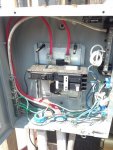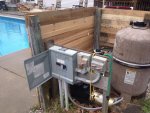Hey folks, I'm dealing with an electrical issue and could use some assistance.
Background: My pool has a niche installed and previously had a light. The old owner drained the pool and stopped maintaining it. Part of this, for whatever reason, was to cut the power cable attached to the light, pull it back into the conduit and plug up the conduit hole in the niche. He left the cable wired to the panel. He re-installed the light after cutting the cable, but he used a wood screw that was a larger thread than the pilot screw.
I have managed to install a new light and run its cable up the conduit and wire it into the panel.
I used a brass pilot screw and it's grabbing some kind of thread because it holds the light in place, but I don't think it's grounding to the niche properly because the circuit trips every time I turn the pool light on.
I know the circuit is good because a receptacle is on the same circuit and it works perfectly, as long as the pool light isn't turned on.
From what I can tell, the niche doesn't have a brass or bronze grounding ring between the niche and the face plate. I think the ground is built into the niche and housed in plastic, but I'm not certain.
Is there some way for me to repair any damage that might have been done by using the wrong screw? Is there a common reason a niche doesn't ground anymore? Where do I go from here?
Background: My pool has a niche installed and previously had a light. The old owner drained the pool and stopped maintaining it. Part of this, for whatever reason, was to cut the power cable attached to the light, pull it back into the conduit and plug up the conduit hole in the niche. He left the cable wired to the panel. He re-installed the light after cutting the cable, but he used a wood screw that was a larger thread than the pilot screw.
I have managed to install a new light and run its cable up the conduit and wire it into the panel.
I used a brass pilot screw and it's grabbing some kind of thread because it holds the light in place, but I don't think it's grounding to the niche properly because the circuit trips every time I turn the pool light on.
I know the circuit is good because a receptacle is on the same circuit and it works perfectly, as long as the pool light isn't turned on.
From what I can tell, the niche doesn't have a brass or bronze grounding ring between the niche and the face plate. I think the ground is built into the niche and housed in plastic, but I'm not certain.
Is there some way for me to repair any damage that might have been done by using the wrong screw? Is there a common reason a niche doesn't ground anymore? Where do I go from here?



